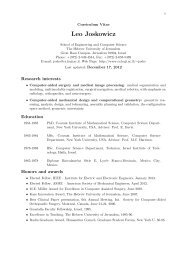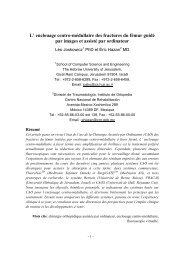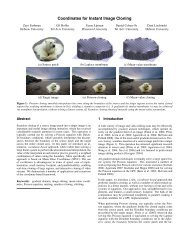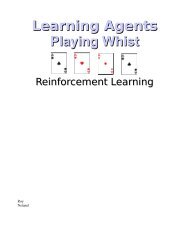TEL AVIV UNIVERSITY Gaddi Blumrosen
TEL AVIV UNIVERSITY Gaddi Blumrosen
TEL AVIV UNIVERSITY Gaddi Blumrosen
You also want an ePaper? Increase the reach of your titles
YUMPU automatically turns print PDFs into web optimized ePapers that Google loves.
w is the complex antenna weight vector which describes antenna excitation<br />
gain<br />
s( ) is the steering vector describing the electrical field in the direction of<br />
each single antenna element and has the form of (assuming antenna gain of 1):<br />
2<br />
2<br />
jm1<br />
d sin<br />
j<br />
Nt1<br />
d sin<br />
<br />
<br />
<br />
s(<br />
)<br />
1,...<br />
e ,... e <br />
(2.2)<br />
<br />
<br />
2.3 Spatial channel modeling<br />
2.3.1 Introduction<br />
Spatial wireless channel modeling is essential for efficient ST processing. Appropriate<br />
ST modeling is essential for determining the best ST processing technique, designing<br />
STC, and getting statistics and measurement for capacity and performance evaluation<br />
as well as for improving the overall performance by better adaptation to channel<br />
conditions. Spatial physical channel models result in a channel response which varies<br />
in space [3, p 43-91]. We will try as much as we can, for simplicity, to eliminate the<br />
use of the spatial dimension as part of the spatial channel modeling, with certain<br />
assumptions. But in most of the cases, it is straightforward to expand the model to<br />
include the spatial dimension.<br />
We start by describing a general spatial physical wireless channel suitable for one<br />
transmit antenna and one receive antenna, later to be called Single-Input-Single-<br />
Output (SISO). The terms Path Loss, fading and multi-path will be explained in the<br />
space, frequency and time dimensions.<br />
Later, we expand the description to a Multiple-Input-Multiple-Output (MIMO)<br />
channel model ([4]-[7]) ,which is the general case for receive diversity Multiple-<br />
Output-Single-Input (SIMO) and transmit diversity Multiple - Input - Single - Output<br />
(MISO), with antenna correlation matrices at the transmit (Tx) and receiving (Rx)<br />
ends.<br />
Next we introduce the term channel feedback quality as was first explored in [8].<br />
We will introduce a new channel parametric model, called virtual channel model, as<br />
was introduced in [9], which is an example for new interesting ST channel model.<br />
In the end of this chapter, we will develop statistical models versus CSI quality for<br />
Gaussian channel assuming flat fading as a function of the correlation between the<br />
real channel and the estimated one and CSI parameters.








